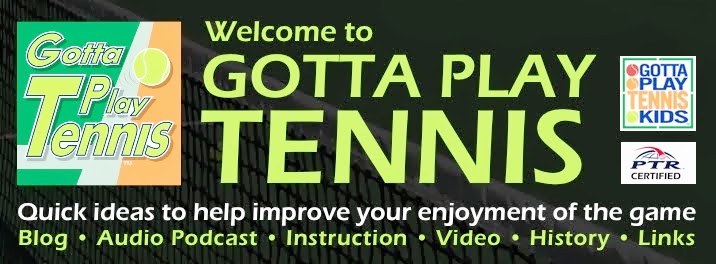Wednesday, July 29, 2009
Tell us what YOU think...Has recreational tennis changed for the better?
When did tennis become only a game of competitive play? Can't two (or 4) players just go out to the court and hit without playing a match? Working on groundstrokes and volleys does not require a finite score to contain them. And you cannot tell me that skills are not acquired simply due to a lack of point play. Learning how to play matches is a totally separate item and may or may not be of interest.
When did tennis, on a recreational level, become about outhitting your opponent with power? Sooner or later, the biggest hitter with the most skill will prevail. So if you are not a big hitter, does that mean you should hang up your racket? Or is it possible to learn how to counter such a barrage? With the variety of tennis shots available, I truly believe that a smart and skilled player can find their own level of success without cannons blazing.
When did tennis become so one dimensional with western-gripped topspin? If I understand correctly, this shot allows one to hit hard and keep the ball in the court. In my day, we did this with a flat shot, slice and sidespin and called it "skill". The better you got at it, the more successful you were. Maybe we didn't hit the ball quite as hard, but you didn't need to because you learned how this big court was ripe for controlled placement of the ball.
When did tennis get so snobbish? Try playing on public tennis courts next to some intermediate players and watch how annoyed they get from stray balls landing in their court from a mom and dad out with their kids. Hey, if you want a tennis club atmosphere, THEN PAY FOR ONE! These same people seem to forget how they began playing tennis. Most people who play tennis do so for free on courts located in a public park. And these are the same consumers who buy rackets, balls, grips, strings, headbands & wristbands, baskets, towels, and sports drinks. Thank goodness all these people exist since Grand Slam tournaments are not broadcast for just the club elite.
I've been playing tennis for over 30 years, and I love some of the innovations in the modern game. But tennis is about having fun, avoiding injury, learning skills and developing them, and becoming more competitive if you so choose. Let's not be too quick to throw out the baby with the bath water.
Sunday, July 26, 2009
Episode 19: A little SLICE of backhand life
Slice your way through some tough spots on the tennis court
Sunday, July 19, 2009
Episode 18: Baselines & Alleys & Nets, Oh my!
Discover why tennis courts are one size fits all, and yet provide enough variety for all skill levels
Monday, July 13, 2009
Episode 17: Put the ball in play...serving basics
Tuesday, July 7, 2009
LISTEN TO INTERVIEW...regarding Slice vs. Topspin
Monday, July 6, 2009
Tell us what YOU think...Is Roger Federer the greatest player ever in the game? Why or why not?
Saturday, July 4, 2009
Episode 16: The grass is always greener at Wimbledon
Thursday, July 2, 2009
HOW TO…What challenges does tennis provide
TENNIS requires only two people, tennis courts are publicly available, and the equipment need is limited and low cost. But don’t be fooled by the seemingly casual face of this game.
Assuming that you want to do your best, it is not a sport for those unwilling to put forth considerable effort. The learning curve is lifetime.
- Tennis is an individual effort with no substitutions.
- Tennis moves fast, with rapid exchanges from the backcourt or net; most times there is little chance to ponder a shot.
One needs to consider all of the following simultaneously: the court boundaries, the type of oncoming shot, and the location of your opponent; you must make decisions within seconds
- Tennis has a social aspect to the game.
You must use everything in your strategy and skill-sets to take the most points. Your ability to hit the most effective shot might be exactly what makes your friends, relatives, boyfriends/girlfriends or spouses frustrated at themselves, and then in turn, angry at you.
You must make all of THEIR line calls, within fractions of an inch on a swiftly moving ball, on your side of the net. Can you imagine if a batter in baseball could call balls and strikes for himself? And what happens when they disagree with the call?
- Tennis is also generally an outdoor sport played under very inconsistent and ever-changing conditions. Particularly problematic are:
– Sun glare (especially on the serve and overhead)
– Light and Dark (as one moves from sunlight into shadow, or from daylight to dusk, or playing under the lights which is again a whole new experience)
– Wind intensity and direction (that blows the ball around making your shots land long, or short, or simply moves the spot where you intended to make contact with the racket)
– Temperature (cooler temperatures harden the rubber inner-ball core and change the bounce)
– Humidity (which makes the outer fuzzy surface of the tennis balls feel heavier)
– Distractions on public courts in community parks (kids squealing on playgrounds, radios blasting, or just a lot of background movement seen through the fence behind your opponent)
- Tennis has the most arcane scoring system and set of rules known to man.
Points are based on the face of a clock using segments of a quarter hour instead of 1, 2, 3, and 4
Even the quarter-hour segments are not consistent since the score is called as 15, 30, and then 40 instead of the expected 45
Matches last 6 games won, or 7 games won as in 7-5, or 6 games won with a tie-breaker played at 6-6 (which can be to 7 points as sudden death or "lingering death". The score is stated as 7-6. And don't even ask me to explain who serves, when, or where!
- Tennis matches have no time limit and no time outs. Since the clock is not an issue, a player cannot use it to waste time while his opponent desperately tries to catch up.
You are always only one service break away from the match totally changing hands. If you play just a few loose points, you can find yourself behind by a set in moments.
Pressure stays focused on you non-stop. The amount of hits in a rally (hitting back and forth) are unlimited, and the length of a match can vary from an hour or so to best of 5 set matches that have taken almost 5 hours in professional tennis. Can you think of any other professional sport that comes close to matching this?
So give tennis a try. It might just be what you were looking for.







